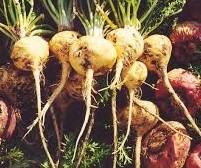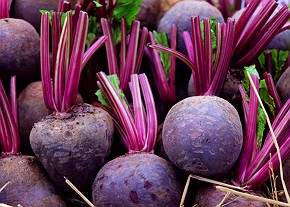* Percent Daily Values are based on a 2,000 calorie diet. Your daily
values may be higher or lower depending on
your calorie needs.
Ingredients / Suggested Use
 Ingredients:
Ingredients: Maca root
(L. Lepedium Meyeni Walp), proprietary
blend of rose hips, orange peel, lemon peel, beet root, purple dulse seaweed, alfalfa grass, barley grass, wheat grass,
spirulina (blue green algae), and chlorella (broken-shell algae) in a special probiotic food base to enhance assimilation.
 Suggested Use:
Suggested Use: Especially good for your morning breakfast or for an afternoon
pick-me-up. Using a blender, mix eight ounces of fruit juice, eight ounces of purified water, 1/2 to 1 cup fruit (bananas
are excellent) and 2 tablespoons of
Maca Manna. You may add other nutritional foods and supplements to add variety
to your shake. O.K. to experiment.
 What is Maca?
What is Maca?

Maca is both a food and a medical herb.
What follows on this page is a brief description. Those wanting more in-depth information
are advised to go to p. 57 of the amazing book,
Lost Crops of The Incas (originally published in 1980).
This link will allow you to download the entire book.

Maca is believed to be the highest cultivated crop in the world.
It grows primarily in the high Andes of Peru (although some is grown in Ecuador, as well) at high altitude.
In fact, most of the maca grown in the world is cultivated at between 3,900 and 4,100 meters (roughly 12,800 to 13,400 feet).
The majority of the plant -- the part that is used -- is the root. Very little of the plant, by mass,
is found above the surface of the ground.
Most of the maca in Peru is grown in Junin, a place east of Lima, where much of the Maca is grown at even higher
altitudes, roughly 4,300 meters (above 14,000 feet). Archaeological sites show that is has been long appreciated
for its many properties, with evidence that it was grown as far back as 1,600 B.C.

After the Spanish conquest in the 16th century, the King of
Spain demanded that part of his tribute be paid in Maca roots. As in the case of Incan royalty,
Spanish royalty kept most of the Maca for themselves. More recently, while sourcing Maca ourselves,
we found that we were having to compete with Chinese buyers, who now rever Maca as being on par
with ginseng and their most invigorating medicinal herbs.
 Maca Manna's
Maca Manna's
Other Ingredients
 Live Food Enzyme Blend
Live Food Enzyme Blend ---
(Barley Grass, Wheat Germ, Alfalfa Grass) ---
These contain pre-digested carbohydrates, proteins, and fats with abundant antioxidants. These grasses are harvested
from their sprouts while only 4-5 inches high with the maximum potency and energy still available. High in natural
vitamins, minerals, and chlorophyll.
 Vitamin C Complex
Vitamin C Complex ---
(Orange Peel, Lemon Peel, Rose Hips) ---
The best part of the citrus fruits is just under their outer skin (or peel). This is where most of the nutrients
are concentrated -- rutin, bioflavonoids, calcium, pectin. This is the part we use. Rose Hips are probably the best source
of Vitamin C anywhere. And it is all from Nature.
 Beet Root
Beet Root -- Beet Root contains phytonutrients that are pretty much absent
in modern diets. This vegetable has been revered for its cancer preventing nutrients. Beets strengthen the lymphatic system,
along with the liver and other vital organs.
 Single-Cell Plant Complex
Single-Cell Plant Complex ---
(Spirulina Blue Green Algae and Chlorella) ---
Spirulina is the most concentrated source of complex vegetable protein on the earth. Very easy to digest. It is a bountiful
source of the B-Vitamins, particularly Vitamin B12, which our bodies do not make and which we must get from our food
on a daily basis. It is also high in Beta-Carotene.

Chlorella is 60% protein and a natural source of growth factors and antioxidants.
It is earth's first green plant. The cells are broken to aid complete nutrient absorption.
 Sea Vegetable
Sea Vegetable ---
(Purple Dulse) --- Extremely rich in minerals, especially
iodine, which has been stripped from so many everyday foods. The nutrients in this seaweed are essential for our health.
Trace minerals from the ocean abound. Our modern diets are severely deficient of these.
 Probiotic Complex
Probiotic Complex --- Probiotic is the name given to beneficial, friendly
micro-organisms and their activity in our bodies, which help us digest and assimilate our food. Our proprietary blend of
probiotics also inactivates toxins, eradicates invasive pathogens and restores nutrient absorption. Included in this blend
are the pure strains of
Lactobacillus acidophilus, Lactobacillus rhamnosus, and Bifido-bacterium longum (one billion
per serving of Maca Manna). These beneficial flora support the health of the G.I. (gastrointestinal tract.)

There's always a battle between the good flora and the bad flora in our stomach and
intestines. If the bad flora take over, we have poor health and disease usually ensues. If the good flora predominate, we
maintain our health.

We know that antibiotics kill all flora, good and bad. So, it is especially important
to replenish the supply of good flora after taking drugs, so as to prevent bad flora from taking hold.